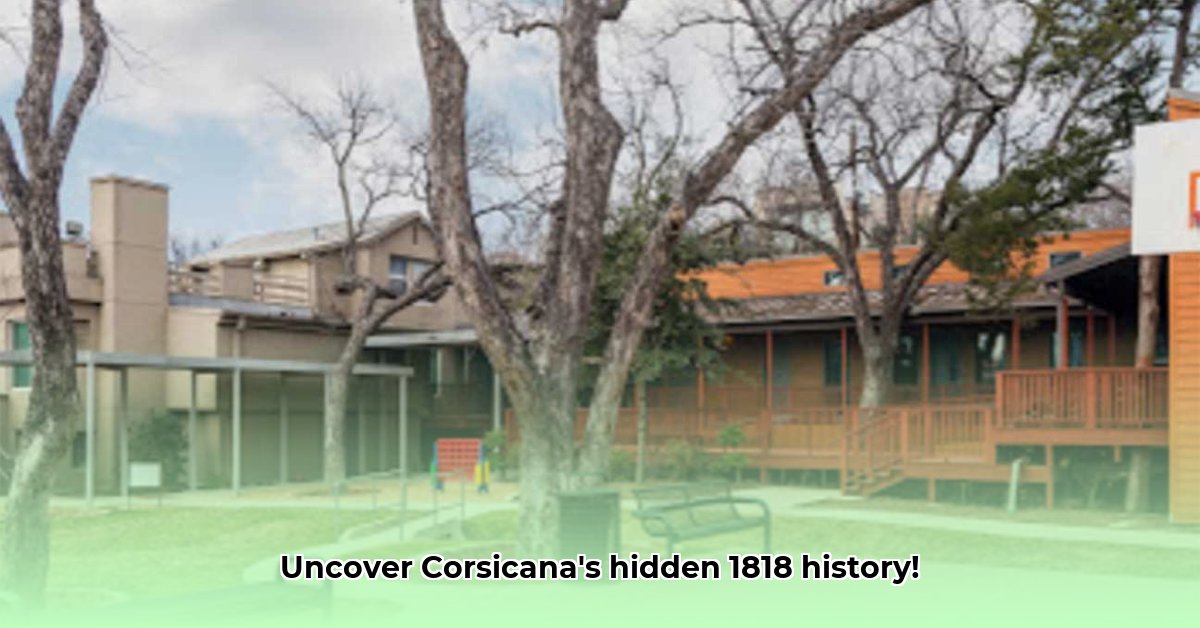
1818 Corsicana: A Glimpse into Early Texas Life
Imagine Texas in 1818: a land of vast plains, burgeoning settlements, and uncharted potential. This article explores the early history of Corsicana, Navarro County, and its connection to the evolving Dallas area. We'll unearth the humble beginnings of this Texas town, examining how its location, resources, and the choices of its early inhabitants shaped its future. Understanding Corsicana’s past offers a valuable context for appreciating the rich tapestry of Texas history.
The Genesis of Corsicana: A Frontier Settlement
The growth of 1818 Corsicana wasn't a carefully planned urban expansion. Instead, its development was organic, driven by the availability of fertile land and accessible water resources, attracting pioneers seeking opportunity in the untamed frontier. These early settlers built homes, established farms, and forged a rudimentary community, their decisions laying the groundwork for the town's future economic trajectory and social fabric.
Early Corsicana and Dallas: Interconnected Destinies
Though geographically distinct, 1818 Corsicana and the Dallas area weren't entirely isolated. Rudimentary trade routes, likely simple trails, connected these emerging settlements. The exchange of goods and people, however slow by modern standards, demonstrates an early interdependence that foreshadows the future interconnectedness of these regions. This early interaction showcases the interconnected nature of Texas's development.
Daily Life: Farming, Community, and the Spirit of Resilience
Daily life in 1818 Corsicana revolved largely around agriculture, with cotton becoming a dominant crop and the cornerstone of the local economy. The social structure mirrored many frontier settlements: a close-knit community where neighbors relied on each other for support. Families worked collaboratively, sharing both the hardships and triumphs of establishing a life on the periphery of civilization. This spirit of cooperation was critical to surviving and thriving in such a nascent environment.
Architectural Echoes of the Past
While most of 1818 Corsicana's original structures are long gone, surviving remnants offer a tangible link to the past. These buildings, often modified and adapted over the centuries, reflect the architectural styles and influences that shaped the early town, providing clues to the lives and cultural impacts that shaped the community. Architectural analysis of even altered structures yields valuable insights into this formative period.
Corsicana's Enduring Legacy: A Story of Perseverance
In retrospect, the significance of 1818 Corsicana and its relationship to the Dallas area is undeniable. It wasn’t just a random outpost; it was a pivotal piece in the larger narrative of Texas's development. Its history demonstrates the resilience, foresight, and ingenuity of its inhabitants who built a community and left an indelible mark on the state's history. The legacy of Corsicana embodies the power of human perseverance in the face of adversity.
Securing Funding for Homeless Shelter Expansion in Dallas
Dallas faces a significant challenge: adequately addressing the needs of its growing homeless population. While the city's existing initiatives show progress, continued funding is crucial for sustained impact. This section explores effective strategies for securing funding to expand homeless shelters in Dallas.
Understanding the Current Funding Landscape: Challenges and Opportunities
Current funding for Dallas homeless shelters requires significant investment. Millions have been allocated for improvements and emergency programs, but these often come from grants with limited lifespans. This creates uncertainty, highlighting the need for stable, long-term funding solutions. Sustainable financial models are paramount to ensure continuous support.
Strategies for Securing Funding: A Multifaceted Approach
Securing sufficient funding requires a multifaceted approach. Strategies include:
Government Grants: Thoroughly researching and applying for federal, state, and local grants is essential. Persistence and meticulous application processes are key here.
Private Foundations: Preparing compelling proposals for philanthropic organizations, emphasizing the shelter's mission and demonstrable impact, is crucial.
Corporate Sponsorships: Approaching businesses to highlight the mutually beneficial aspects of aligning their brand with a community-focused initiative can yield significant results.
Crowdfunding: Utilizing online platforms to build public awareness and generate individual donations through impactful storytelling and transparent reporting.
Individual Donations: Encouraging direct donations through personalized messaging emphasizing the direct impact on lives.
Building a Winning Funding Proposal: Key Elements
A successful funding proposal must:
- Clearly articulate the critical need for shelter expansion in relation to the growing homeless population.
- Provide compelling evidence of the shelter’s existing impact and demonstrate substantial community benefit.
- Present detailed and realistic financial projections, justifying every element of the expense budget.
- Propose a sustainable funding model beyond short-term grant cycles, ensuring long-term viability.
- Emphasize the long-term benefits of expansion for both the individuals served and the overall Dallas community.
Measuring Success and Ensuring Accountability: Transparency and Impact
Transparent financial management and robust data collection are vital to demonstrate accountability to both funders and the community. Regular reporting on program outcomes and impact builds trust and credibility, allowing the Dallas homeless shelters to refine their strategies based on measurable results and data-driven insights. This is crucial for long-term success and continued funding.